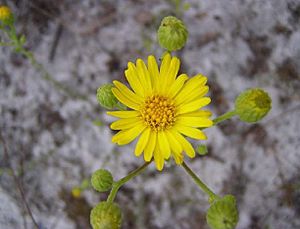Chrysopsis floridana facts for kids
Quick facts for kids Chrysopsis floridana |
|
|---|---|
 |
|
| Conservation status | |
| Scientific classification | |
| Kingdom: | |
| (unranked): | |
| (unranked): | |
| (unranked): | |
| Order: | |
| Family: | |
| Genus: | |
| Species: |
C. floridana
|
| Binomial name | |
| Chrysopsis floridana Small
|
|
| Synonyms | |
|
|
The Chrysopsis floridana is a very rare flowering plant. It is also known as the Florida golden aster. This plant is part of the aster family. It grows only in Florida, United States. You can find it in Hillsborough, Hardee, Manatee, and Pinellas Counties. It mostly lives near Tampa Bay.
In 1986, this plant was added to the US endangered species list. This happened because it was becoming very rare. Its home was often on private land and was not protected. This meant its habitat was being destroyed. Today, you can find it at Bell Creek Nature Preserve in Riverview, Florida.
Contents
What Does the Florida Golden Aster Look Like?
This plant is a short-lived perennial herb or small shrub. It grows about 30 to 70 centimeters (1 to 2 feet) tall. It has roots that spread out like rhizomes. Its stem stands up straight and has woolly hairs. The leaves are also very hairy and have glands. The lowest leaves can be up to 10 centimeters long.
At the top of the plant, there are many branches. These branches hold 1 to 25 or more flower heads. Each flower head has many bright yellow petals called ray florets. These are less than one centimeter long. The Florida golden aster blooms in November and December. Its fruit is a tiny achene, only two millimeters long. It has a small tuft of bristles on top. These fruits are carried away by the wind to spread new seeds.
Where Does the Florida Golden Aster Live?
This plant likes open areas. It grows in a type of habitat called Florida scrub. You can often find it among sand pines. It also grows where the scrub meets other types of land. The soil it prefers is white siliceous sand. This sand was once part of old dunes. This sandy soil does not have many nutrients. It also does not hold much water.
Why Was the Florida Golden Aster Endangered?
When this plant was listed as endangered, it faced many dangers.
Threats from Human Activity
The Florida golden aster grew only in or near busy towns. Its biggest threat was losing its home. This happened because land was cleared for houses and shops. Other problems included mowing and railroad upkeep. People also used the land for dumping trash.
Off-road vehicles also damaged the land. Too much grazing by livestock hurt the soil too. While the plant can handle some disturbance, too much activity led to erosion. Most of the known plants were on private land. There were no rules to protect them. Some groups of plants were even in the middle of fast-growing neighborhoods.
Competition from Other Plants
The Florida golden aster is not good at competing with strong plants. These include saw palmetto (Serenoa repens). It also struggles against introduced and invasive species. Examples are Natal grass (Melinis repens) and Bahia grass (Paspalum notatum).
The plant also needs a lot of sunlight. It cannot grow in the shade. So, if tall plants grow around it, it often dies. The natural fire regime in Florida scrub helps. Regular wildfires clear out overgrown plants. This allows plants like the aster to grow in the sunlight. Many of these fires start from summer lightning. Studies show that the aster flowers more after a recent fire. Because of this, natural or controlled burns are important for its recovery.
How Is the Florida Golden Aster Being Saved?
A plan was made to help this rare plant. This plan has worked well and shown good results. Some of the land where the plant grows was bought for conservation. Other landowners have agreed to put fences around sensitive areas. They also protect the plant in other ways.
Now, controlled fires are used in many areas. New groups of these plants have been found. Young plants have also been planted in safe areas. This includes bringing the plant back to places where it had disappeared.
The plant still faces some threats from habitat loss. However, it is much less than in the 1980s. Losing its home to development is not a "major" problem anymore. The main goal for its recovery has been met. The species now meets the rules to be moved to a less endangered status. In 2009, the Fish and Wildlife Service suggested that the plant be changed from endangered to threatened status.


